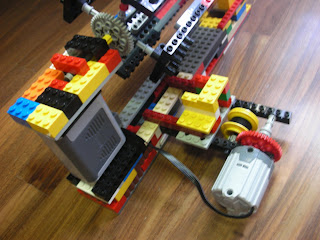I haven't been making any Lego guns for a while now because I don't have enough of those studded beams. But a few months ago I found out that a shop called the Hidden Chamber in Thomson Plaza sells individual parts. That isn't very far from my home and I have been buying parts from there ever since.
Here's my assault rifle made primarily out of those beams found in RCX sets. Another source of those beams are Lego City sets and certain Technic sets, as well as Lego Star Wars sets.
Inspiration was from a few YouTube videos. I figured out the mechanism and incorporated it in this gun.
The mechanism is extremely simple. There is a rammer that is inserted into the magazine before loading. This rammer is connected to a spool at the top of the gun by dental floss. I chose dental floss because of its tensile strength. Once the rammer is inserted, we can begin loading the gun. Bullets (3-hole studless beams) are loaded into the magazine. Each of the bullets have a rubber band tied to the middle hole. When loading, the rubber bands are stretched and hooked onto a beam at the front of the gun. The magazine can hold around 20 rounds, although I don't have 20 of those 3-hole beams.
|
|
The trigger is connected to a PF IR transmitter, tuned to the same channel as the IR Receiver behind the gun. Six PF M-motors serves to drive the spool. A lot of power is required to turn the spool and pull the rammer up due to the friction between the ammo and the magazine. When firing, the bullets are forced up the magazine and fired.
This is the strongest gun I've ever made. The bullets have awesome power and range. They can penetrate paper with ease as well as cause some nasty bruises. To be honest I'm scared of this gun. But also proud of my creation.
And just a note to anyone who want to try building this, you have to make the magazine really strong, or else it will bend and break under all the pressure exerted by the rubber bands. Also I would recommend using dental floss, because every other string that I tried had broke. Also I found out that 20 bullets is really all that Lego can handle, anything more and the Lego pieces can't take the stress, either that or the string will break. If you're thinking to use a rack-and-pinion method to pull the rammer, I would say that it's useless. I've tried and failed, the Lego components can't take the stress.
Here's the video of this gun firing. If you can't see the bullets because of quality issues, just listen to the noise (or watch the targets fall)


































